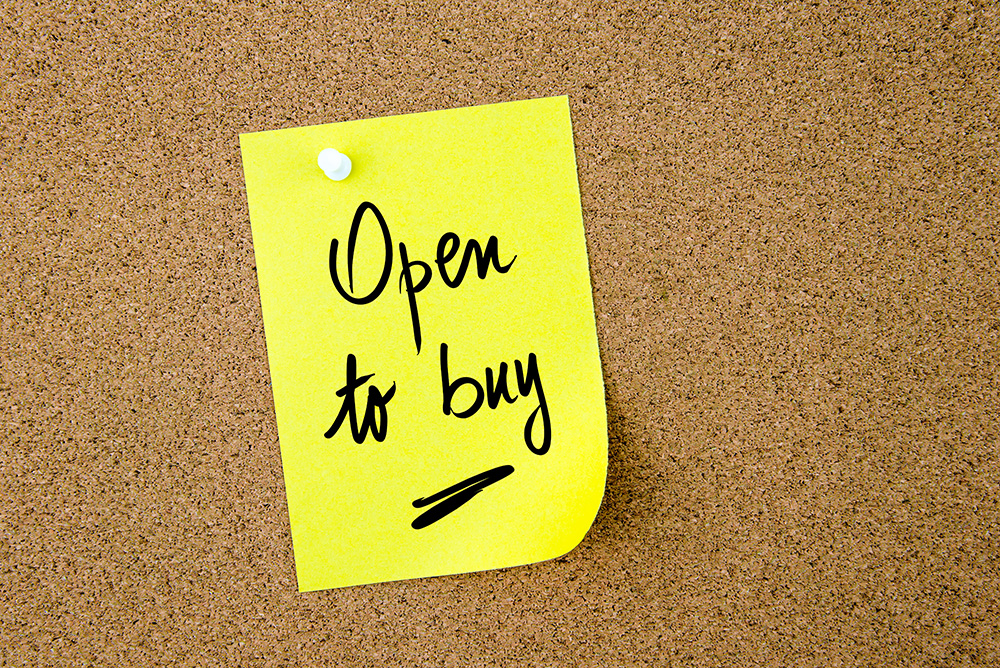Those confusing and intimidating words… Open to Buy. What do they mean? In reality, Open to Buy is really not that complicated and it is a tool that every retailer, whether large or small, should be using.
Open to Buy is a financial budgeting tool that retailers use to manage inventory and make the best use of their purchasing dollars. By using an Open to Buy tool, businesses can work smarter and improve their financial performance. Inventory is the largest investment of a retailer and by using an Open to Buy, a retailer can see trends in sales, know where their inventory is, and plan for future receipts. Open to Buy (or OTB) refers to the dollars that are “open to buy”, or dollars left to be spent.
It all starts with a sales plan. Retailers must first develop a sales plan, usually by month. They must also have goals for gross margin and inventory turn. Inventory turn is the number of times a retailer can sell through the merchandise in the specified time period (Sales dollars ÷ Average Inventory dollars). The amount of inventory carried should support the sales plan, taking into consideration minimum stock levels needed for store presentation as well as vendor lead times and how often reorders are done. For example, if my vendors have a 90-day lead time, I would want to make sure that my minimum inventory level equals my minimum presentation amount plus my sales for the next 90 days. From there, an Open to Buy can be developed at a high level, such as a division, or broken down into departments and classes. It is best for the sales plans to be in dollars, rather than units, since the costs and revenue can differ greatly from one item to another.
There is a debate on whether it is better to use Full Retail dollars or Cost dollars in an Open to Buy Tool. If Full Retail dollars are used, you will want to add Mark downs into your Open to Buy Equation. However, as a word of caution when planning, if you had excessive markdowns in the past, you don’t want to make the mistake of continually planning for that.
For this example, we are going to use Cost Dollars for our Open to Buy. The formula for Open to Buy is:
OTB = Planned COGS (cost of goods sold) + Planned Ending Inventory – Planned Beginning
Inventory – Inventory on order expected to be received that month
Here is an example of a simple Open to Buy:

As you can see in this example, we have an Open to Buy of $200 in Jan, $100 in Feb, -$100 in March and $100 in April. Receipts are budgeted each month to maximize cash flow and enable the retailer to bring in fresh merchandise on a regular basis. It is usually a good idea to leave some dollars open to be able to react to changing trends. If too much inventory is carried, it will tie up cash flow and could reduce profits if the inventory is in the wrong categories and markdowns need to be taken. You would not be able to react to up-trending items. If there is not enough inventory, sales may be missed and profits lost. This may also lead to unsatisfied customers.
An Open to Buy is a working tool. As actual Sales and Receipts are realized, the Open to Buy Tool is updated. Based on trends and changes in the Marketplace, future sales can be projected and entered in the Open to Buy tool. This, of course, would change the Projected Ending Inventory for each of the future months, as well as the Open to Buy dollars. In addition, gross margin is usually included in an Open to Buy tool. This tells the retailer which departments and classifications are the most profitable. All of this valuable information provides the retailer with a roadmap to follow. Strategic decisions can be made to increase sales and profits. Faster turning categories may be funded more than slower turning categories. Planned receipts can be shifted from an underperforming category to one that is performing well. At minimum, the Open to Buy should be worked once a month. Many companies find it beneficial to review each week.
All retailers can and should realize the benefits of an Open to Buy Tool. They will have visibility to their inventory investments by department or category and be able to recognize sales trends and evaluate future purchasing decisions. Customer satisfaction will increase because there is adequate inventory to cover sales and fresh merchandise receipts are arriving each month. An Open to Buy is an invaluable tool for every retailer.




